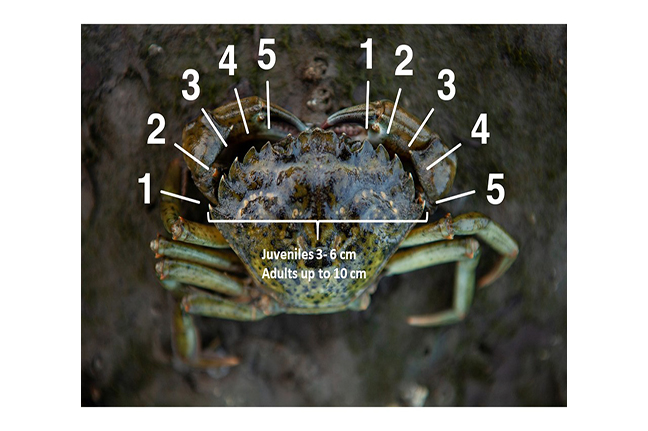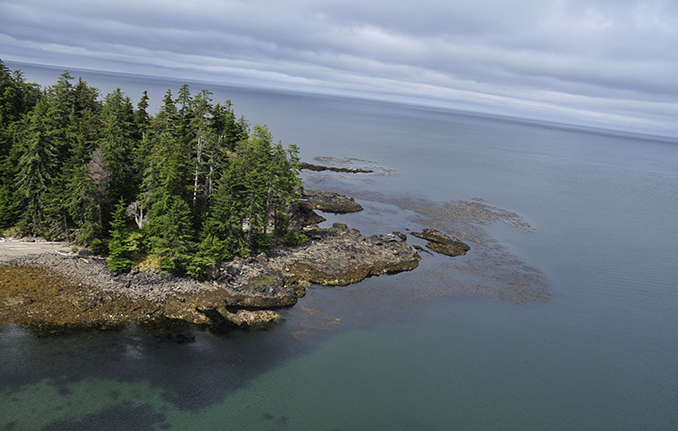Invasive European green crab found on Haida Gwaii

Figure 5: European Green Crab found in Daajing Giids a few days ago. Photo Credit: Clint Johnson
After planktonic larvae of the European green crab (Carcinus maenas) were discovered in Lax Kw’alaams waters near Kxeen Prince Rupert last winter, local biologists have been on high alert here on Haida Gwaii. The European green crab was introduced to California in the 1980s and has slowly been moving northward ever since. In 2011 they were discovered in Gale Passage near Bella Bella, but until now no juveniles or adults had been documented anywhere north of there. Unfortunately, a couple of days ago, while walking his dog, Gwaii Haanas Resource Management Officer Clint Johnson found a small number of adult male and female European Green Crabs near Haydn Turner Camp Ground in Daajing Giids Queen Charlotte.
Especially the find of adult crabs, including a female specimen is worrisome. “Right now we don’t know the extent of the population at all, so our first next step is to sample. We need to act fast to assess the population so we can figure out what to do. Any green crabs that we catch while sampling will also be removed from the ecosystem, which is good,” says Stu Crawford, Ecosystem Based Monitoring Coordinator for the CHN Marine Planning Program.
European Green Crabs are highly invasive and can rapidly destroy whole eelgrass beds. While they can’t outcompete the larger adult k’uust’an Dungenesss crabs or sguskaahll red rock crabs, “they are voracious predators that are aggressive towards any and all smaller crabs or other animals,” according to Mr Crawford.
The CHN, Gwaii Haanas, Fisheries and Oceans Canada, and the Province of BC have been working together to monitor and manage marine invasive species on Haida Gwaii. For the past three years, CHN and Gwaii Haanas have been monitoring a few sites around Haida Gwaii for European green crab in partnership with DFO and the province.
Let’s keep native crabs safe
While we would love people’s help in keeping their eyes open for the European green crab and reporting any additional sightings, it is very important to not harm native crabs by falsely identifying them as invaders.
How to Identify the European Green Crab
The European green crab is often green in colour, but it can also be yellow, orange, or mottled. The best way to identify a European green crab is that they have five very obvious spines on the side of each eye. The shape of their carapace is also distinctive and it is as long as it is wide. They can get up to four inches across their carapace, but this early in the invasion most of the adults will likely be smaller.

The European green crab is not always green, and some of our native species can be green. However, the five obvious spines of the European Green Crab clearly differentiate it from all native crabs.
“Please count the spines before harming a native crab, some of our local crabs can be green. Colour can be misleading, thinking of them as the “five spine crab” could save native greenish crabs,” Mr Crawford advises.
Count five spines and be sure it is a European Green Crab before killing any crab and make sure to report any findings to invasives@haidanation.com. If you are unsure whether or not you have a European green crab, gather it in a container to keep it alive and send us a photo.

Native shore crabs can also be green. However, they only have 3 spines lateral to their eyes and these spines are often not very pronounced. Their carapaces are also more square than a European green crab. Photo credit: Washington Sea Grant/University of Washington

Dungeness crabs and red rock crabs have way more than 5 spines lateral to their eyes. Their carapaces are also wider than they are long. Photo credit: DFO



3 Comments
Josina · July 10, 2020 at 7:34 pm
I”m impressed that you got this story up so quickly.
Laurie Chisholm · July 10, 2020 at 8:43 pm
Very informative and rather scary. While indroduced, how do they they increase their presence?
Mark Leyden · July 13, 2020 at 8:06 am
Thanks for the information. Excellent article!